High Quality
Custom Bass Guitars
11 June 2003
Conversation with Fatdog and Romain
Fatdog: Here's a new series of top quality custom basses that
Romain is building and assembling out of alot of old stock and parts,
like Alembic, Warmoth and Bartolini. I call it a new world/old world
fusion, combining to make these new basses.
Romain's a real good musician, and he's fond of Alembic and Bartolini
electronics. Romain likes Alembic pickups so much, he's building alot of
these basses with the Alembics installed.
Romain: I wanted that set up, but you can't find it in France
-- only Bartolini -- not Alembic pickups.
FD: He's having a field day, wallowing in Fatdog's endless
stash of old parts, building whatever he feels like. He's building each
one as if it were his own dream.
Romain: Perfect coordination between the body and the pickups,
makes for a much better jazz bass. A real Alembic doesn't give the
possibility to slap that I want; the Alembic doesn't allow me to be
free, as I like.
FD: Because there's no room because of its design and
construction.
So what is the solution?
Romain: Fatdog's solution. The first thing that I noticed when
I came to the shop was to see that Yamaha bass with Alembic pickups. I
couldn't help but try it. It feels perfect to me. Also, those 5-string
Oden basses -- which are really good: you can hear the definition of the
lower B strings, all the way up to the peghead -- to F -- which you
hardly hear when you have a modified bass. Well, you've got it, but you
have to have a special attack. For example, Trace Elliot has done a head with
a real EQ -- for the 5th or 6th strings lower.... But what you need is a
way that you can fit in any amp. Versatile.
Romain: The Oden bass -- as it is -- with this Alembic pickup
and also the way its set, can give perfect tone. For example, if I want
to record on stage, I know I won't have to have a certain EQ or DI box
to hear my lower strings back down there. It hardly buzz.
FD: And the reason? Its the geometry -- the neck angle and
the geometry of the basses you're making, make it so that it works. On the
Alembic, bass strings are too close to the body.
Romain: For example, if I were playing an Alembic, I would
automatically hit the pickups. They're really great instruments --
don't get me wrong; but they were made a long time ago, in a time when
nobody was really slapping -- it wasn't an issue then. Absolutely.
FD: In fact, we have an Alembic bass that somebody routed out
a big trough in there, just for slapping. They sortof defaced the
instrument to get that effect. This has to be filled in because they
routed channels -- took alot of the wood away under the strings -- so
you can slap it.
Romain: That was the problem with Alembic. They made some
new ones that I tried in Germany, where you have alot of different
Alembic setups. The bass sounds very good, but I mean, its not made for
this slapping....
FD: What you have here is the synthesis of the old classic
Fender-style with more of the modern Alembic electronics -- and
playability.
Romain: For example, if I want to slap the Alembic, there is
a buzz happening down here. There's no room. I hit metal pickups. Even
if you were to adjust the bass, the string of the bass, it will be too
high to be on time for a certain kind of lick. But the Alembics
electronics are TOPS. Really, really top. Its the best -- after
Fender, they're the BEST.
FD: And its also cheap. All these instruments are a fraction
of what they would cost if they were made by Alembic. And these are
constructed using USA Warmoth quality wood, and Bartolini active tone
circuits.
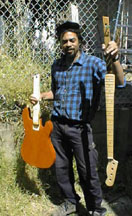
Romain Dru
with
a custom telecastor bass (work in progress)

Warmoth jazz
bass
turquoise alder body, maple neck, Alnico pickups, maple
control plate.

Danny Ransom birds'eye
maple neck jazz bass
Chocolate alder body, Alnico jazz bass
pickups, birds'eye control plate.

Warmoth 5-string
fretless bass
Birds'eye maple and ebony fretboard. sissy lines.
Ash body, Alembic pickups, ebony control plate, Bartolini NTBT active
tone.

Black Schechter jazz
bass
USA ebony fretboard and control plate. Alnico pickups and
black hardware.

Left handed Warmoth
fretless 5-string bass
Ebony fretboard, Bartolini pickups and
koa body.

Custom Gibson les paul
bass with Alembic pickups and Bartolini NTBT
Great custom
bass! built by Romain Dru.

Warmoth Korina jazz
bass
with Fender neck, Gotoh gears, Alembic jazz bass pickups
and Bartolini NTBT active tone.

Warmoth Korina jazz bass
body
Fender neck, Gotoh GB-7 gears and EMG jazz bass pickups.

Lefty
fretless jazz bass
Warmoth neck, ebony fretboard with sissy
lines. Alnico jazz bass pickups and ebony control plate.

Red
Farington acoustic P-bass
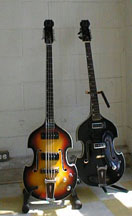
Black
Univox fiddle bass and sunburst Univox fiddle bass
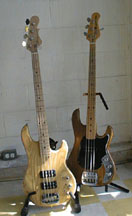
The evolution of Leo:
G&L l-2000 bass and MusicMan Sabre bass
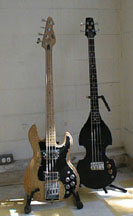
One of the greatest
values for a bass player
USA made $300 (but you don't
get chicks playing this one) and Solid body long-scale fiddle bass.
Westbury. MIJ 1979. $450
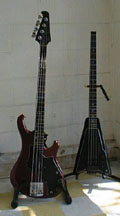
Gibson Victory bass and
Steinberger flying wing bass
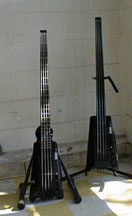
Hohner fretted and
Hohner fretless
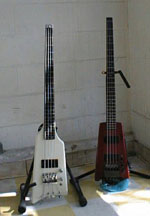
Krammit white
dookie-stick and Red Hohner headless
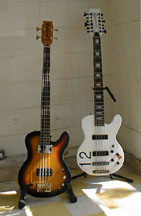
Multivox 12-string
bass
something a New Jersey dentist extracted and something
that fell off of an Austin Powers set.
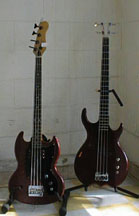
Kalamazoo Gibson SG bass
(60s) and a weird aluminum neck USA Krammit
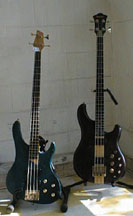
Washburn and Ibanez
Musician
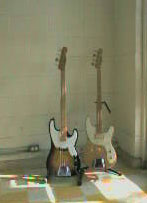
Ibanez-built 70s
telecaster bass copy and a Warmoth-built sunburst telecaster bass
copy
Both were owned by some neurotic, obsessed guy who just
had to have Fender stickers on everything

Custom Fatdog bass
with solid mahogany body, Warmoth bird'seye maple and ebony
fretless neck, Bartolini pickups and NTBT active tone and a Fatdog
modernesque PJ. $375
More from Romain
Alembic has the most definition of sound. For
example, when you go on stage, you want to play that hit. When you send
the sound by the monitors source, you still hear your note, its not
loose. So on top of the bass you've got alot of electronics active.
When the sound guy sends the sound back, as soon the band plays, you
don't hear yourself anymore. The sound is already EQ. You want to have
a neutral kind of sound, which gives perfect freedom to put some color
in. Its a kind of electronic thing.
I saw Stanley Clark and George Duke -- on stage -- in 1983 in France.
That sound was what I mean. I'm really a great Stanley Clark fan, he's
a great contrabass player, but I'm more into Larry Graham. Anyway, I
could hear that same sound. He had this Alembic -- a really beautiful
one -- with lights for the fret marks. That was something specially made.
When he did this particular lick, there was this incredible definition,
filling the whole room with his sound. You could hear every little
sound so clear. It was -- WHOA! really amazing.
Stanley was really the best, using the Alembic sound. Johnny Crystal
was good, but Stanley was really more. For that matter, Stanley Clark is
the Alembic EXPERT. When you hear all the recordings that he's done --
from the 70s and 80s -- especially one called Rock, Pebble and Sand --
he really put the bass up front. He even said how he did it. You can
really hear the Alembic sound. Its definitely Alembic, Alembic,
Alembic.
He's been using a really special recording of it. What he did was
really very simple: He took two big speakers -- some kind of mark like
Electrovoice -- and he put those two in different rooms with mikes on.
Some of his bass was going straight into the mixing board, so. Of
course, when he played, the full sound of the bass was going straight
through the decks PLUS what was going to those cabs.
It also gives like a really heavy thing. I've got to say: These basses
will really blow your mind.
Subway Guitars
1800 Cedar Street
Berkeley,
California 94703
(510) 841-4106
noon til six, Monday thru
Saturday
Pacific Time

HOME





















